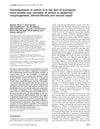Androgen Receptor-Mediated Inhibition of Cutaneous Wound Healing
September 2002
in “
The Journal of clinical investigation/The journal of clinical investigation
”
TLDR Blocking testosterone speeds up wound healing in males.
The study found that androgen receptors (AR) played a significant role in inhibiting wound healing in C57BL/6 mice, with increased AR expression in various skin cells during early wound healing stages. Castration accelerated healing, reduced wound areas, and increased collagen deposition, indicating that male gonadal steroids, particularly testosterone, inhibited healing by directly affecting epidermal/dermal cells or the inflammatory response. Reduced TNF-α expression and inflammation in castrated mice implicated TNF-α as a key factor regulated by gonadal steroids. Human studies supported these findings, showing slower healing in elderly males compared to females, linked to higher testosterone levels and increased TNF-α. Blocking AR with flutamide mimicked castration effects, reducing inflammation and accelerating healing, suggesting testosterone delays wound healing by enhancing inflammation through AR.
